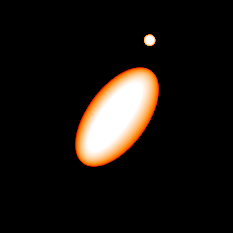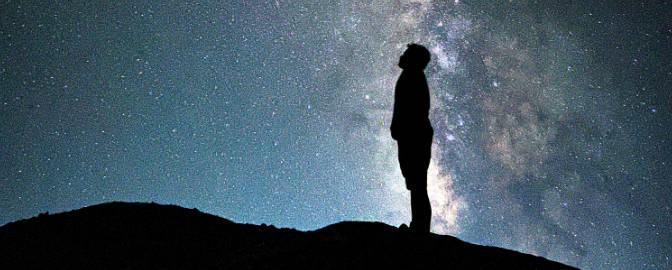Emily Lakdawalla • Nov 11, 2010
DPS 2010: Centaurs and Trans-Neptunian objects
While cleaning out my files to switch to a new computer I realized I never posted this entry from a month ago. Better late than never!
I attended all day Tuesday of the Division of Planetary Sciences meeting on October 5, but even though I was there all day I had to make tough decisions about what to see: there were three concurrent oral sessions running all day. In one room there was stuff on Pluto and other bodies way out there in the solar system; in the next room, a session on Saturn's rings; and in the third room, new stuff from Mercury and the Moon. All of these were exciting, but I finally decided that since I pay pretty close attention to what Cassini's doing at Saturn and to what MESSENGER has been doing at Mercury, I would be most educated by sitting in the "way out there" sessions on Pluto, Eris, and the other icy stuff beyond Neptune.
The afternoon session on Tuesday was a grab bag about different small objects in the outermost solar system. The first talk I saw was given by Matthew Person on behalf of James Elliot, about an object so relatively insignificant that it doesn't have a name, going instead by 55636. The story Person told of observing Kuiper belt objects 55636 was pretty cool. He pointed out that because the orbital characteristics for most of these smaller bodies are not known very precisely, that it's pretty tough to predict occultations; the positional uncertainty of the bodies is larger than their diameters. But without occultations, we can't actually pin down how large these objects are. So he said their group has been working very hard to improve the astrometry of these very small, very faint bodies. Their work paid off with the prediction of an occultation of a star by 55636 that might be visible from Earth on October 9, 2009. Which, Person pointed out with amusement, was just about exactly one hour before the scheduled impact of LCROSS with the Moon, and while last year's Division of Planetary Sciences meeting was going on in Puerto Rico. Despite the overscheduling of telescopes and astronomers, Person reported success in observing the occultation with two telescopes, one of them the 2-meter Faulkes North telescope on Haleakala, and the other one being a 36-centimeter portable telescope set up in the parking lot of a Mauna Kea visitor center!! (Needless to say, the Haleakala data were better, but the occultation was clearly detected in the smaller telescope.) Person said that this was, to his knowledge, the very first stellar occultation by any Kuiper belt object other than Pluto to be observed. The timing of the occultation shows that 55636 is even smaller than had previously been thought, only about 286 (plus or minus 10) kilometers in diameter, assuming a circular shape. Allowing for elliptical shapes, it -- like its parent body, Haumea -- has an incredibly high albedo, around 0.88, making it among the most reflective known bodies in the solar system.
Meg Schwamb gave a talk on a survey of large Kuiper Belt objects using Palomar, but her advisor Mike Brown's unbelievably fast speech seems to have rubbed off on her; I had a tough time taking notes.
Speaking of fast talkers, Mike Brown was up next, talking about the fact that the observed Kuiper belt objects vary immensely in density, from densities below water ice to above 3.5 grams per cubic centimeter, which is denser than most rock, requiring very little ice and even some metal to be present. Unlike the terrestrial planets, which have high densities in part to the compression of their materials under self-gravity, none of the Kuiper belt objects (not even Pluto or Eris) is large enough to be able to increase its density through self-compression. So, Mike said, it's often hypothesized that large impacts could smash the ice off of differentiated bodies, leaving behind rocky cores. While the Kuiper belt objects do show evidence for major collisions in the past, models show that you can't increase density by very much at all through even the very biggest impacts, through a mechanism that he described as pyramidal growth of differentiated bodies. The bodies that were forming in the Kuiper belt experienced not one but very many very big impacts, each one of which might have driven off about 10% of its mass, preferentially the outermost water ice, slowly concentrating the densest stuff in bodies that experienced the most impacts. You'd need to have started with a lot of big Kuiper belt bodies to make this work, though, and it apparently still fails to explain the very densest of the bodies. (This work presaged this week's announcement that Eris may have unusually high density and smaller diameter than Pluto.)
Will Grundy talked about using Hubble and also adaptive optics equipped telescopes to begin to determine the mutual orbit characteristics of trans-Neptunian binaries. He said they've now determined the mutual orbits for 24 binary systems. When you look at these things projected on the sky, there's a "mirror-plane degeneracy" where there are two possible solutions for the orientation of the orbital plane. But if you watch them long enough, Grundy said, you can break that degeneracy and actually determine which direction one body is traveling around the other. They've done this now for 11 objects. Of these, "prograde orbits are definitely winning."
At that point I took a break, and evidently missed a very interesting talk by Bruno Sicardy on a stellar occultation by Varuna. A reader on unmannedspaceflight.com exchanged emails with Sicardy to find out that he reported that Varuna has a highly elliptical shape, with its long axis twice as long as its short axis, with its major axis between 660 and 1130 kilometers long. Quite a bit of uncertainty there!!
The last talk in the session was by Darin Ragozzine, another of Mike Brown's fast-talking students (and a frequent guest poster here) on Hubble Space Telescope observations of Haumea. Unlike nearly all of the other talks in this session, Darin's was not about a stellar occultation. Rather, it was about observing mutual events of Haumea and its moon Namaka, which happen to be observable now through an incredibly fortuitous chance alignment of Namaka's orbital plane along the line of sight from Earth. "For all that we've studied Haumea," he said, "we don't know a lot of things. We don't know its shape. We know its albedo is high, but not what it is. The spin orientation we have no constraint on. We don't know how big the satellites are." They have a chance of pinning most of these down if they can catch Namaka passing in front of Haumea's disk and watching how that changes Haumea's light curve, but these are incredibly difficult observations. One thing that makes it extra hard, Darin said, is that there's an outer satellite, Hi'iaka, which rotates once per five hours -- it is not tidally locked with Haumea for reasons that no one can yet explain -- so Hi'iaka has its own light curve that adds variation to the Haumea-Namaka light curve. Darin was very happy to report that they are now confident that they have successfully detected the first mutual event between two Kuiper belt objects after Pluto and Charon. This one happened on June 18 and was of a particularly interesting type, in which both Namaka and its shadow crossed Haumea's disk. Mike Brown has (as usual) a very clearly written web page that looks like it was posted in 1993 but is really very recently updated that explains just how much there is to be learned from these Haumea-Namaka mutual events.

More from DPS still to come!!


 Explore Worlds
Explore Worlds Find Life
Find Life Defend Earth
Defend Earth

